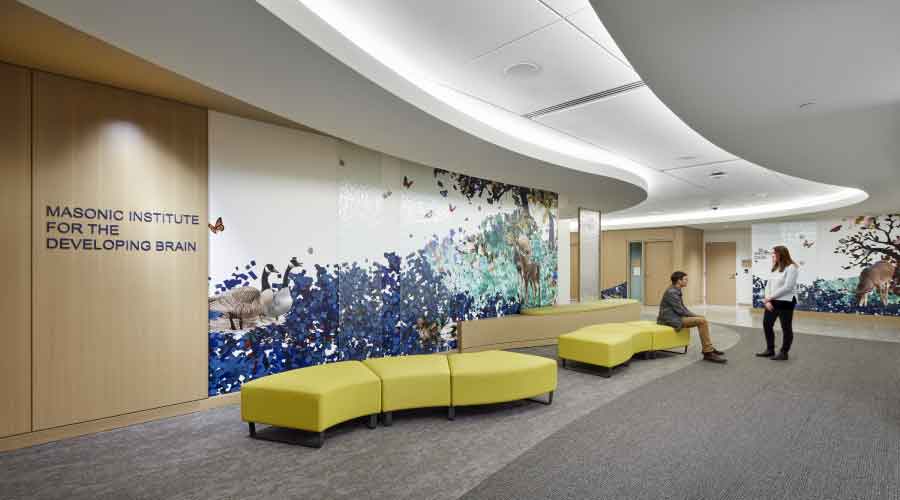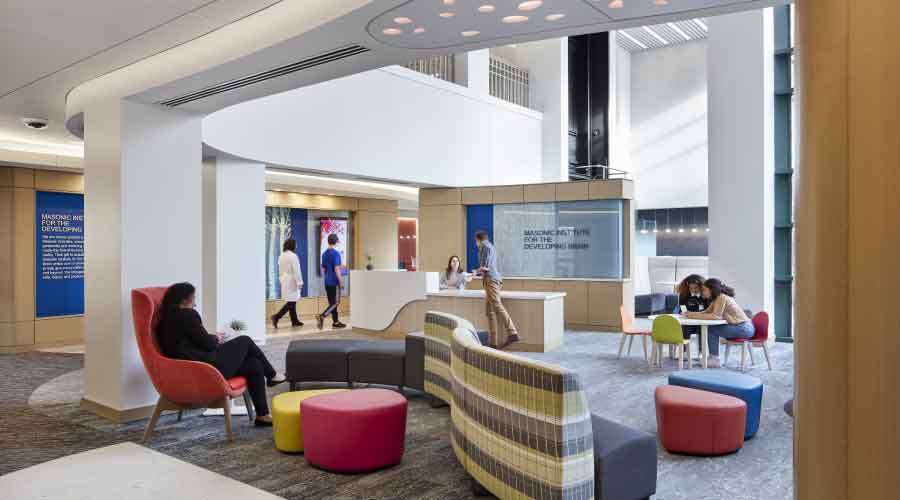
Masonic Institute for the Developing Brain Serves as a Destination for Research Through Design
HGA and Knutson Construction partner on the facility to make it a welcoming environment. September 16, 2022
Located near the Twin Cities campus of the University of Minnesota, the Masonic Institute for the Developing Brain (MIDB) works to advance brain health for early childhood and adolescent patients, and their families, with the help of educators and researchers from across the University as well as M Health Fairview clinicians.
Designed by multidisciplinary design firm HGA and built by Knutson Construction, MIDB’s new two-level, 117,000 square-foot home, once a Shriners Children’s hospital, was reimagined as a destination for neurodevelopmental research, clinical care, education, community engagement and outreach.
Entering from the main circular drop-off point, patients and their families step into a two-story atrium backed by large windows that provide natural light and views of nature. The reception area features colorful furniture, cozy and kid-friendly alcoves, and beautifully crafted wall murals depicting MIDB’s pastoral setting along the Mississippi River. Created by HGA and the MIDB University Project Team, the art is carried throughout each floor, with main floor murals reflecting the flow of the nearby river and second floor murals depicting the treetops that run alongside it. Mural designs were chosen to not only appeal to young children but also to MIDB’s teen, adult patients and research participants.
Through research and user engagement, HGA created spaces that support the diverse sensory needs of participants, patients, and their families. A vibrant and colorful playroom overlooking the outdoor playground provides energetic children (or their siblings) a space to be active. For children who prefer a quieter space with less stimulation, a calm room is available with muted colors and subtly textured wallpaper. Even the lobby, waiting rooms and visitor lounges include child-friendly amenities.
Areas of different size and visual design were strategically placed to provide moments of adjustment, ease of wayfinding, appropriate levels of privacy and positive distraction through graphics and texture. Signage throughout the public and patient-focused areas directs visitors to their destination with cheerful animal images.

Design with Collaboration in Mind
The project also presented an opportunity to support collaboration and create synergies across functions that had rarely shared physical space while also accommodating the diverse behavioral and neurological conditions of patients and research participants.
HGA developed a program in concert with various stakeholder groups to integrate research and clinical spaces and share resources to maximize the potential of the existing building. Placing program elements such as shared breakrooms central to shared officing, created connections between clinicians and researchers and maximized opportunities for collaboration, or positive “collision” between these functions.
Health for the Patient and the Planet
The project was designed under Minnesota’s Sustainability Guidelines (B3 v3.1) and meets the goals of many of the AIA Framework for Design Excellence categories including design for Integration, Equitable Communities, Economy, Well-Being and Resources
Leveraging a Design-build Contracting Approach
This project was a true design-build partnership from the very beginning. Since Knutson was actively on board from the start of pre-design, constructability was always top of mind. Being 100 percent involved in the pre-design and preconstruction allowed for everything to flow smoothly. The project included an extensive remodel in an old building so it took a full team effort to figure out solutions in the field and deploy them immediately to maintain the schedule.
The design-build integration helped the project realize the University of Minnesota’s goals for MIDB:
- To become a first-of-its-kind institute in the country as a destination for neurodevelopmental research, clinical care, education, and community inclusion, engagement and outreach
- To knit together an unprecedented combination of functions that will foster collaboration and innovative research
- To support scholarly work through the lens of cross-disciplinary teams and metrics to study early childhood and adolescent neurobehavioral health in new and exciting ways
Next
Read next on FacilitiesNet













